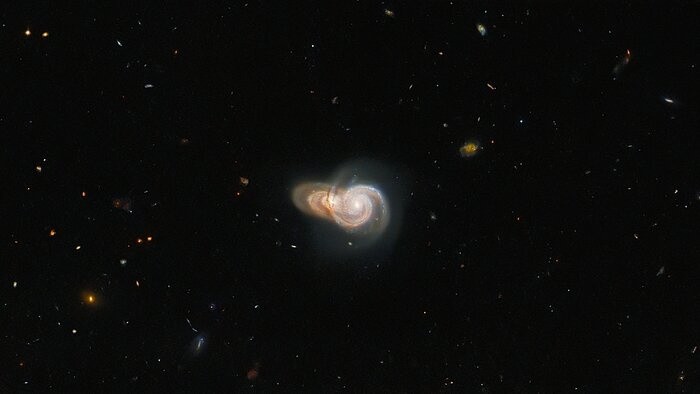A galactic display of affection seems to have been captured deep in space with two galaxies overlapping each other!
NASA's iconic Hubble Space Telescope holds a plethora of stunning images of the universe, and this recent photo shows a "galactic connection" as it shows two spiral galaxies connecting with each other.

Purely by Accident
The galaxies are more than a billion light-years away from Earth and are referred to as SDSS J115331 and LEDA 2073461. The European Space Agency (ESA), a partner in the observatory, said that while the new Hubble Space Telescope picture appears to show the two galactic entities merging, it is only optical illusion galaxies aren't truly interacting with one another at all.
The alignment of the two galaxies was captured purely by accident; they are not truly interacting, despite the fact that they look to collide in this image. While these two galaxies may be just passing ships in the sky, Hubble has photographed a stunning collection of interacting galaxies before this new image as well.
Galaxy Zoo Project
One of many Hubble observations exploring key aspects of the Galaxy Zoo project is this image. The Galaxy Zoo project, which began in 2007, and its offshoots are enormous citizen science initiatives that crowdsource galaxy classifications from a pool of hundreds of thousands of participants.
These volunteers categorize galaxies that robotic telescopes have captured, and they frequently are the first people to ever see an astronomical object, according to ESA.
Volunteers working on the initial Galaxy Zoo project found a variety of bizarre and amazing galaxies, including unusual 3-armed spiral galaxies and colliding ring galaxies.
The astronomers overseeing the project filed for Hubble time to observe the unique inhabitants of the Galaxy Zoo - but true to the initiative's crowdsourced roots, the list of targets was determined by a public vote.
Read also : NASA'S Hubble and Chandra Xray Revives a Dead Star Back to its Original Form Before its Violent Explosion
Webb's Sharp Image of Orion Nebula
Meanwhile, James Webb Space Telescope has recently captured the sharpest, most detailed image of the Orion Nebula, known as the "picture book of star creation." It is located in the constellation Orion, 1,350 light-years from Earth.
Ionized gas, hydrocarbons, molecular gas, dust, and scattered starlight are all shown in this composite image created by combining the results of several different filters.
Scientists from more than 100 different institutions across 18 different nations collaborated under the name PDRs4All to acquire the photos as part of the Early Release Science initiative.
Related Article : NASA's Hubble Space Telescope Captures a Dazzling Starscape That Will Leave You Wonderstruck
This article is owned by Tech Times
Written by Joaquin Victor Tacla
ⓒ 2025 TECHTIMES.com All rights reserved. Do not reproduce without permission.




